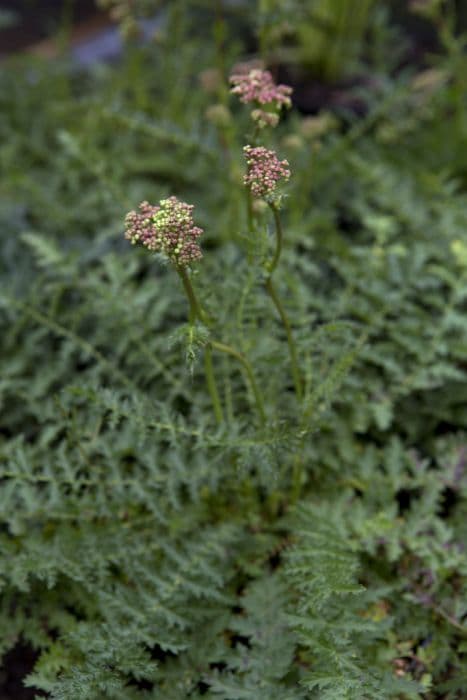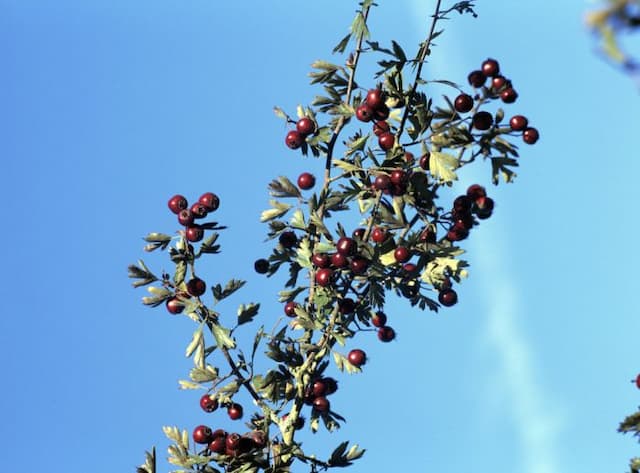Dropwort Filipendula vulgaris

ABOUT
The plant commonly known as meadowsweet features a clumping form with deeply divided, pinnate leaves that are dark green on the top and pale beneath. The foliage provides an attractive, fern-like texture to gardens. In the flowering season, the plant bears airy, branching clusters of small, creamy white flowers that have a delicate, fluffy appearance and a sweet fragrance. These blossoms are comprised of tiny, densely packed blooms that contribute a softness to the plant's overall look. The flowers are held atop tall, reddish stems which rise above the foliage, giving the plant a light and graceful presence. The contrast between the green leaves and the white flowers is visually striking, making meadowsweet a favored choice for naturalistic plantings and wildflower gardens.
About this plant
 Names
NamesFamily
Rosaceae.
Synonyms
Dropwort, Fern-leaf Dropwort, Meadowsweet, Meadow Queen, Pride of the Meadow.
Common names
Spiraea filipendula, Filipendula hexapetala, Ulmaria filipendula, Ulmaria vulgaris, Filipendula denudata, Filipendula vulgaris var. hexapetala, Filipendula vulgaris var. denudata, Filipendula vulgaris var. plena.
 Toxicity
ToxicityTo humans
The plant commonly known as dropwort, Filipendula vulgaris, is considered toxic to humans if ingested. The plant contains chemical compounds that can be harmful, such as salicylates, which are similar to aspirin. If consumed, symptoms of poisoning may include stomach pain, nausea, vomiting, diarrhea, headaches, and in severe cases, may lead to kidney damage. It is important to seek medical attention if ingestion is suspected.
To pets
Dropwort, or Filipendula vulgaris, is similarly toxic to pets as it is to humans. Pets that consume any part of this plant might exhibit signs of poisoning such as vomiting, diarrhea, abdominal pain, and lethargy. In severe cases, dropwort ingestion can cause kidney damage in animals. If you suspect your pet has ingested dropwort, it is important to contact a veterinarian as soon as possible.
 Characteristics
CharacteristicsLife cycle
Perennials
Foliage type
Deciduous
Color of leaves
Green
Flower color
White
Height
2 feet (0.6 meters)
Spread
2 feet (0.6 meters)
Plant type
Herb
Hardiness zones
3
Native area
Europe
Benefits
 General Benefits
General Benefits- Ornamental value: Meadowsweet is often used in gardens and landscapes for its feathery, cream-colored flowers and fern-like foliage.
- Attracts pollinators: The flowers of meadowsweet are rich in nectar and attract bees, butterflies, and other pollinating insects.
- Erosion Control: Meadowsweet's root system helps stabilize soil and prevent erosion, particularly along riverbanks and in wet areas.
- Culinary uses: In some regions, the plant is used as a flavoring agent for beers, wines, and vinegars.
 Medical Properties
Medical Properties- Anti-inflammatory: Filipendula vulgaris has been traditionally used for its anti-inflammatory properties, which may help reduce inflammation.
- Diuretic: The plant has diuretic effects, which can help increase the passing of urine.
- Astringent: It is considered to have astringent properties, which can help tighten tissues and reduce secretions.
- Antirheumatic: Has been used in traditional medicine as a treatment for rheumatic conditions.
- Febrifuge: It is also known to have febrifuge (fever reducing) properties.
 Air-purifying Qualities
Air-purifying QualitiesThis plant is not specifically known for air purifying qualities.
 Other Uses
Other Uses- Filipendula vulgaris, commonly known as meadowsweet, has been traditionally used as a strewing herb due to its pleasant fragrance, to freshen indoor spaces and repel pests.
- The dried flowers of meadowsweet are sometimes incorporated into potpourri mixtures, contributing a subtle, almond-like scent.
- Meadowsweet, due to its astringent properties, has been used in natural dyeing processes to fix colors on fabrics.
- The plant can be placed among linens and clothes to impart a sweet smell and deter moths and other insects.
- Meadowsweet is occasionally used in the floral industry as a filler in bouquet arrangements due to its feathery foliage and small, clustered flowers.
- The plant has been used in traditional ceremonies and rituals, symbolizing love and peace, often woven into garlands or crowns.
- In some food preparations, meadowsweet can be used to flavor jams, jellies, and alcoholic beverages with its unique aroma.
- Meadowsweet’s flowers are sometimes used as a natural flavoring for homemade sorbets or ice creams.
- The plant has been used to create a natural air freshener by simmering it in water, releasing its sweet fragrance into the air.
- Culinary experiments have included meadowsweet in the infusing of vinegars and syrups to impart its aromatic qualities to various dishes and drinks.
Interesting Facts
 Feng Shui
Feng ShuiThe Dropwort is not used in Feng Shui practice.
 Zodiac Sign Compitability
Zodiac Sign CompitabilityThe Dropwort is not used in astrology practice.
 Plant Symbolism
Plant Symbolism- Protection: Filipendula vulgaris, commonly known as Dropwort, has been historically used in folk medicine and magic rituals as a protective herb against negative forces and evil spirits.
- Purification: The plant's antiseptic properties contribute to its symbolism of cleansing and purifying spaces and individuals from harmful influences.
- Love: It has been used in love spells, and its graceful appearance contributes to its association with romance and attracting love.
- Peace: With its calming presence in natural settings, Dropwort symbolizes tranquility and the restoration of peace.
 Water
WaterThe common name for Filipendula vulgaris is "Meadowsweet." When watering Meadowsweet, it is important to keep the soil consistently moist but not waterlogged. During active growth in the spring and summer, water thoroughly once a week, providing about 1 to 1.5 gallons per plant, depending on the size and the weather conditions. In particularly hot or dry spells, you may need to increase this to twice a week. Reduce watering in the autumn as the plant starts to die back and further in winter when the plant is dormant, but ensure the soil doesn't completely dry out. Always check the top inch of the soil for moisture before watering to avoid overwatering.
 Light
LightMeadowsweet thrives best in full sun to partial shade. It prefers a spot that receives at least four to six hours of sunlight daily but can tolerate some shade, especially during the hottest part of the day. Avoid placing Meadowsweet in deep shade, as this can lead to poor growth and fewer blooms.
 Temperature
TemperatureMeadowsweet is hardy and can tolerate a wide range of temperatures but grows best in temperatures between 50°F and 75°F. It can survive minimum temperatures down to about -30°F once established and can handle summer highs around 85°F. To ensure healthy growth, avoid planting in areas where the temperature drops below -30°F or exceeds 85°F for prolonged periods.
 Pruning
PruningPruning Meadowsweet is essential to maintain its shape and to encourage more blooms. Prune in late winter or early spring before new growth starts by cutting back the dead or old stems to the ground. This promotes healthier plants and better air circulation. Deadheading, or removing spent flowers during the blooming season, will also encourage a second wave of blooms.
 Cleaning
CleaningAs needed
 Soil
SoilMeadowsweet prefers fertile, well-drained soil with consistent moisture. A loam-based mix with organic matter and perlite for drainage suits it well. The best soil pH range for Meadowsweet is between 6.0 and 7.0, slightly acidic to neutral.
 Repotting
RepottingMeadowsweet rarely needs repotting, as it is typically grown outdoors. If grown in containers, repotting every 2 to 3 years or when rootbound is sufficient to refresh the soil and accommodate growth.
 Humidity & Misting
Humidity & MistingMeadowsweet thrives in average garden conditions and does not require high humidity. It is tolerant of a wide range of humidity levels typically found in outdoor environments.
 Suitable locations
Suitable locationsIndoor
Provide bright light, moist soil, and good air circulation.
Outdoor
Plant in moist soil, partial to full sun, ensure good drainage.
Hardiness zone
3-8 USDA
 Life cycle
Life cycleDropwort (Filipendula vulgaris) starts its life cycle as a seed, which germinates in early spring, given adequate moisture and light conditions. Upon germination, seedlings develop a root system and shoots that grow into basal leaves. As the plant matures, it develops a flowering stem and a cluster of small, creamy-white flowers emerges, usually in early to mid-summer. After pollination by insects, the flowers develop into small dry fruits (achenes), which are dispersed by wind or animals. These achenes can lie dormant in the soil before germination, introducing a period of seed dormancy into the life cycle. The plant also spreads vegetatively through its rhizome, a horizontal underground stem, allowing for perennial growth and survival through winters.
 Propogation
PropogationPropogation time
Spring to early summer
Propogation: The most popular method of propagation for Filipendula vulgaris, commonly known as Dropwort, is by division. This typically takes place in the early spring or autumn. To propagate by division, carefully lift the plant from the ground using a garden fork, ensuring that you keep a good amount of roots attached to each clump. Gently tease apart the clumps into smaller sections, each with roots and shoots. Then, replant these divisions at the same depth they were growing before, spacing them about 12 to 24 inches (30 to 60 centimeters) apart to allow for growth and air circulation. Water the new plants well to help establish them. This method is favored for its simplicity and the speed with which new plants can grow and flourish.









